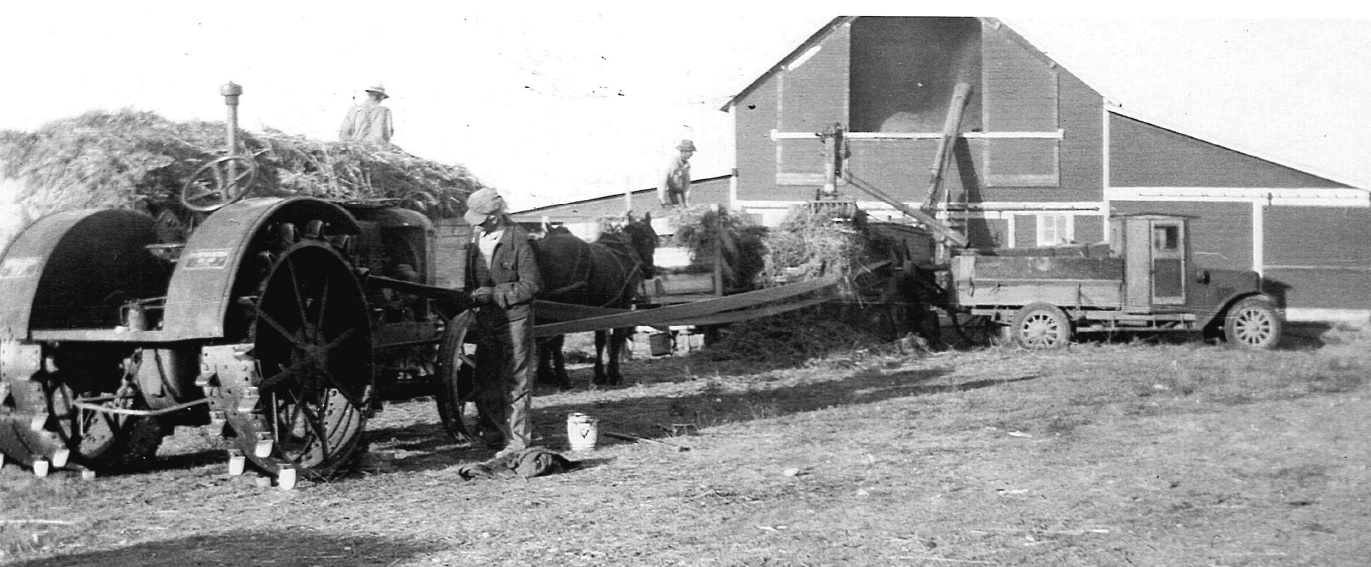MHS Honors Two New Centennial Farm and Ranch Properties

The Montana Historical Society (MHS) has added two new sites to the state’s Centennial Farm and Ranch program in the past three months.
The new inductees include the Nels Jensen Sorensen homestead and the Tange Lazy AK Farm, both in Sheridan County. The two century properties received a signed certificate from Gov. Greg Gianforte and a roadside sign to honor their families’ remarkable achievement.
The Sorensen and Lazy AK farms both tell important stories about Sheridan County’s cultural and agricultural history. Nineteen-year-old Danish immigrant Nels J. Sorensen did not speak English and had few possessions when he arrived in America in 1906, but he had a wealth of skill, energy, and determination to start a new life. Nels grew up on a diversified farm in northern Denmark and was trained in woodworking and blacksmithing. From New York he took the train west to join his brother Soren in North Dakota. Soon after, he moved further west to Dagmar, Montana, where he became a partner in a well digging business.
In 1909, Nels filed on a homestead six miles north of Dagmar. He lived simply in a sod house, continued digging wells, (often in exchange for planting or plowing) and was able to purchase additional land nearby. In 1910, he built a small wood-frame house and in 1911, married a neighbor, Frederikka Johnson. By 1912, they reported 120 acres plowed. Nels was never idle. When he wasn’t improving the homestead, he repaired machinery, sharpened tools, and made horseshoes for neighbors in his blacksmith shop. He also built a flour mill on the homestead so neighbors could grind wagon loads of wheat into fresh flour. In addition, the Sorensen’s housed and maintained the cooperative threshing machine owned by several area farmers.
Nels and Frederikka had ten children and farmed together for more than forty years before passing the farm to their son Nels, Jr. and his wife Violet. They farmed for another forty years until Nels, Jr. died in 2009. Violet now leases the land, but lives on the farm with her daughter, granddaughter, and great grandson who will someday keep the land in the Sorensen family.
By 1914, most of the land near Dagmar had been claimed, so Danish immigrants Jens N. and Johanna Tange claimed a 320-acre homestead about four and a half miles northwest of Redstone. Jens and Johanna were both born in Denmark and emigrated to Wisconsin in the early 1900s. They were married in Racine, Wisconsin, in 1911 and traveled west seeking better opportunities. Jens was a carpenter and built their homestead house in 1914, followed by a well and windmill, and a barn in 1915. Jens and Johanna had three boys, Alfred, Leonard, and Arnold, who was born in 1917 at the beginning of a long dry period.
They suffered through drought and depression after 1917 but were still able to acquire an additional 160 acres. Arnold fell ill in 1921 so Johanna traveled with him to the Mayo Clinic in Minnesota for medical help. Arnold was diagnosed with diabetes and died in December 1922. Devastated but determined, the family persevered through the 1920s and 1930s, keeping the farm going through the worst years of the Great Depression. Although they were of the Lutheran faith, they found a supportive community at the Methodist Church in Redstone.
In the early 1930s, Leonard attended the University of Montana and went to work as an aeronautics mechanic at Lockheed in Glendale, California. In 1937, Alfred married Mora Stone and Jens and Johanna retired and moved to California to live with Leonard. Alfred and Mora continued the farm, raised two girls, Kay and Diane, and eventually expanded the original homestead to include more than 2,000 acres. In 2002, Kay’s son Corwyn Nelson, who grew up helping Alfred on the farm, bought the property. He continues the Tange family legacy and is busy raising wheat, lentils, dry peas, flax, safflower, chickpeas, cattle, chickens, and horses.
Since 2009, the MHS Centennial Farm and Ranch program has recognized our state’s agricultural traditions by celebrating the perseverance and stewardship of Montana families on their farms and ranches.
“By honoring families who have owned their land for 100 years or more, we help preserve Montana’s strong agricultural roots and the stories and traditions that define our rural communities,” said Christine Brown, MHS Outreach and Interpretation Historian.
The MHS will accept applications for the Centennial Farm and Ranch program from Jan. 1, 2021, to Nov. 30, 2021. Requirements for induction include:
- Must be a working farm or ranch with a minimum of 160 acres or, if fewer than 160 acres, must have gross yearly income of at least $1,000.
- One current owner must be a Montana resident.
- Proof of founding date and continuous ownership by members of the same family beginning with the founder and concluding with the present owner, spanning minimally 100 years. Line of ownership may be through spouses, children, brothers, sisters, nephews, nieces, or adopted children. For homesteaded properties, ownership begins with claim filing date (not patent date).
To download all requirements and the application, or for more information, visit http://bit.ly/MTCFRapp; email christine.brown@mt.gov to request a copy by mail; or call Christine Brown at 406-444-1687.
